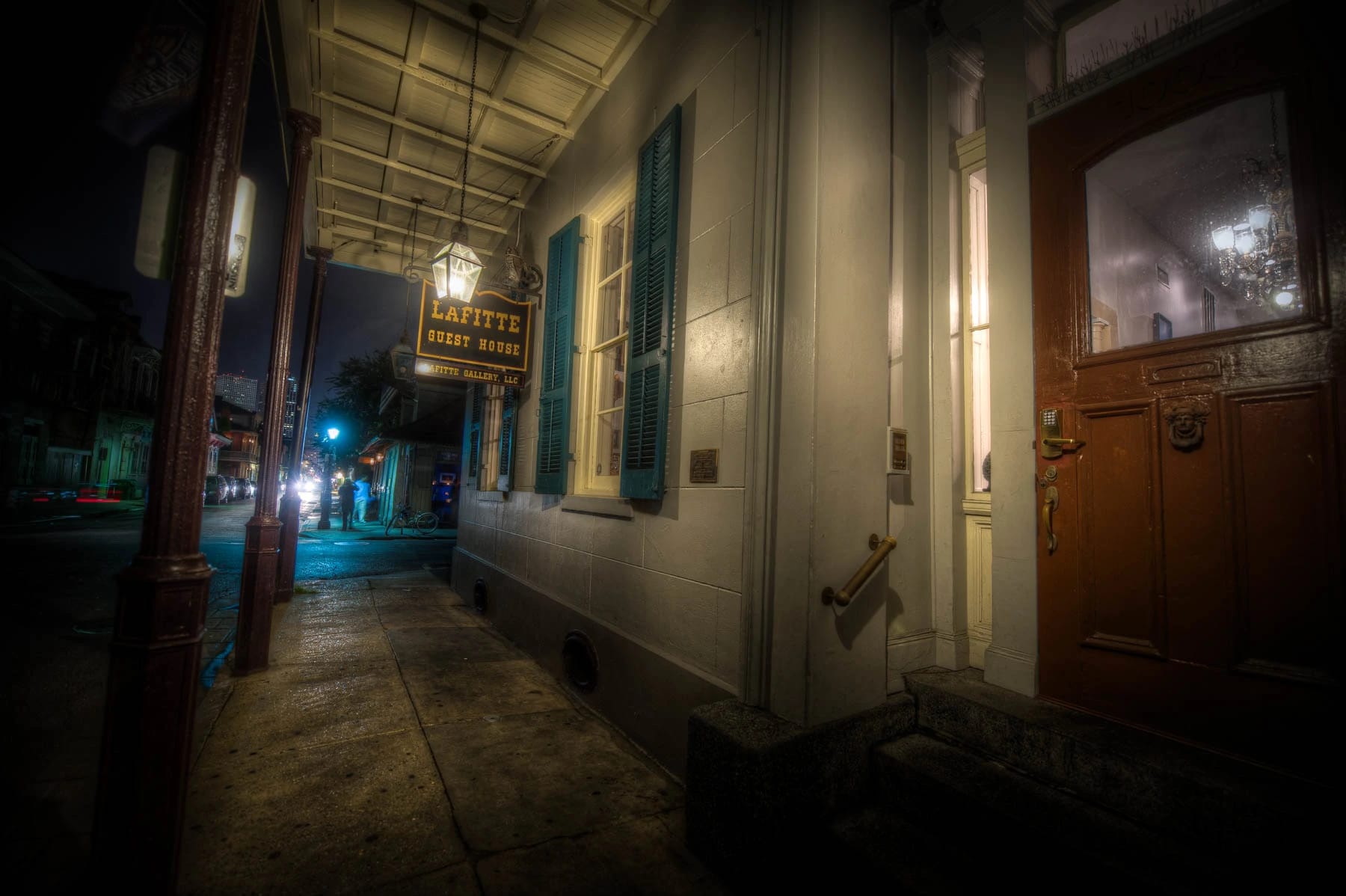Without doubt, Bourbon Street is New Orleans' most visited street (the Vegas Strip has got nothing on this French Quarter 24/7 party). Mardi Gras beads are thrown from second-floor wrought iron balconies to (un)suspecting tourists meandering the crowded street below; the neon green, long-as-my-forearm Hand Grenade bottle is a sight most frequently seen; and the sounds of jazz and blues and Cajun zydeco intermingle with laughter and conversation and the _clip-clop_ of the NOPD's horses. But the farther that you walk away from Canal Street, the sounds ease and fade to a soft humming in your ears. On the cusp of the residential portion of Bourbon Street, and sharing the same block corner as the notorious [Lafitte's Blacksmith Shop](https://ghostcitytours.com/new-orleans/haunted-places/lafittes-blacksmith-shop/), is another establishment named in honor of the infamous, down-and-dirty pirate. [The Lafitte Guest House and Gallery](https://www.lafitteguesthouse.com/) is a beautiful three-story French-style building dating to the nineteenth century. Today, it is one of the most visited boutique hotels in the French Quarter, in part because of its excellent location, in part because it also operates as an art gallery with constantly changing exhibits, and also because, well, it's haunted.
The History of the Lafitte Guest House
Under the Guardianship of Charity Hospital
1003 Bourbon Street and the surrounding plots of land was not always the site of New Orleans' Charity Hospital; instead, this is just one of a few locations that the hospital found itself during the eighteenth and nineteenth century.
Upon arriving in New Orleans in 1718, fresh-faced colonists from France and other Europeans countries quickly realized that New Orleans was, tragically, a pit of disease. The first hospital within the Crescent City was Royal Hospital on Ursulines Avenue, not so far off from The Old Ursulines Convent, the oldest building west of the Mississippi River. Jean Louis, a French sailor, had bequeathed money in his will for the construction of a hospital at the time of his death in the 1730s. It was equipped, and intended, to deal with only one sort of condition: venereal diseases.
(I know, a whole hospital and the only thing "treated" were the Frenchmen's STD's, of which there were multitudes of cases. Priorities, right?).
Royal Hospital was initially called Hospital of St. John, or L'Hospital des Paupers de la Charité (The Charity Hospital for the Poor) and is the second oldest hospital in the United States. By 1736, the first "official" Charity Hospital was officially built at Chartres and Bienville Streets. Later, it functioned under the jurisdiction of church and government during the Spanish colonization period, much to the disgruntlement of the general public. Under the control of the Spanish Council, laws were passed to enforce the regulation of the surgeons who operated upon the so-called "indigent" (or poor). For example, if a patient died after three days of illness without having had a consultation, the doctor in command was deemed guilty and fined "40 livres for the house of charity."
One has to wonder how problematic a doctor's neglect was toward his patients during this period that a law was installed to counteract such bad habits. (Answer: Probably really bad.)
Unfortunately, a storm in 1778 weakened the hospital's structure, and a subsequent hurricane in 1779 brought the hospital to a "heap of ruins." It would not be until three years later in 1781 that the Council decided to build a new hospital, the San Carlos. Until then, the poor and sick literally had no where to go and sometimes laid in heaps on the streets.
San Carlos Hospital (Charity Hospital) was constructed on a portion of the property where Lafitte Guest House is today. And, according to newspaper reports and memoirs, it was apparently the stuff of legends. Real Estate Entrepreneur Don Almonaster invested all kinds of money into the property, and he agreed to donate five slaves to the Institution as well. Reportedly, one of the men named Domingo was instructed in the art of surgery and was the designated phlebotomist—he was even given the lead authority in the surgery ward!
But much like the other hospitals in New Orleans, which had faced unfortunate endings, San Carlos (or Charity Hospital) was no different. In 1809 it burned down, and what was left of some of the property was sold off to other bidders.
The Middling Years: the Lafitte Brothers
After Charity Hospital met its tragic end, a simple wood and brick home was constructed on the property. For a period of a few years, 1003 Bourbon Street was owned by a few different people, though during the mid-1810s it fell into rather famous hands.
The hands of the pirate Pierre Lafitte, Jean Lafitte's brother.
Author William C. Davis of The Pirates Lafitte once wrote that, "where today stands the Lafitte Guest House at 1003 Bourbon Street, Lafitte residence is confirmed by Marie [Louise] Villard's August 16, 1816 purchase. The association of the Lafittes with her and the property, even if one does not assume that Pierre bought it for her in the placage arrangement, is confirmed three years later after she sold and then repurchased it in 1819, in part with a promissory note guaranteed by Jean Lafitte."
Within New Orleans during the eighteenth and nineteenth centuries, the system of placage was intrinsic within the societal hierarchy. Women of mixed race were deemed "Quadroons" if they were one-fourth African, "Octaroons" if they were one-eighth African, and so forth. As they were considered the most beautiful and exotic, the French Creole men desired them as mistresses, though they (almost) never wed them. (The system is much more complex than this and if you are interested in reading more, check out this article written by well-regarded historian Jan Doherty).
A woman like Marie Louise Villard, then, was gifted a grand residence to call her own; in return, a man like Pierre Lafitte had companionship. "Companionship" until he might formally wed another, a French Creole woman.
Except that pirates no doubt played to their own tune, and there is no indication that either Pierre or Jean ever married. Instead, Pierre purchased the humble dwelling at 1003 Bourbon Street in 1816 for his Marie Louise. She was the mother of all seven of his children—leading us to believe that this was a love match, perhaps—and Marie Louise's sister, Catherine "Catiche" Villard was actually in a separate relationship with Jean. It is on this property that Catherine gave birth to Jean Pierre, Jean Lafitte's son, in 1816.
And, considering that records of the Archdiocese of New Orleans show that Catherine Coralie Lafitte (the daughter of Pierre and Marie Louise Villard) was married in 1826, it seems safe to say that Marie Louise and Pierre's so-called "arrangement" was a longstanding one.
Although the house in which the Lafitte brothers lived no longer exists, the boutique hotel still boasts their name. Really, who wouldn't want to stay in a location that the pirate Lafitte brothers have been historically proven to have lived?
The Current Residence
The building that is Lafitte Guest House today was built in 1849 by builder Joshua Peebles for debt collector, Paul Joseph Gleises, his wife Marie Odalie Ducayet, and their six children. (It was commissioned for a staggering $11,700 by the way, a hefty sum of money in the mid-nineteenth century). The architect, Robert Seaton, was also responsible for the design of the New Orleans Opera House.
The Gleises family continued to live in the home at 1003 Bourbon Street until 1866 when it was sold. The reason for selling the grand mansion is something of a mystery, though historians believe that perhaps Gleises did so to avoid paying extremely high homeowner taxes during the Reconstruction Era following the Civil War.
Over the next century, the property was owned by various families. Not until the twentieth century did it become a hotel, and today, the Lafitte Guest House and Gallery is owned by Hugh Stiel, Subway Restaurant Development Agent entrepreneur.
The Ghosts of the Lafitte Guest House
The Haunted Room 21
According to Mark, the hotel's marketing guru, Room 21 of the hotel is probably the most haunted room at the Lafitte Guest House—and it is definitely the most requested room within the hotel. But who exactly is haunting this room?
Her name, allegedly, is Marie. As the story goes, Marie was one of the Gleises' young daughters, only about eight to ten years old, when she fell desperately ill. Some might say that yellow fever is New Orleans' biggest killer and they would be correct. Within two months in the summer of 1853, for example, some 10,000 people died within the Crescent City. Whether Marie was one of the victims of yellow fever during that particular year we will never be quite certain, but we do know that Marie never left 1003 Bourbon Street once she had succumbed to the disease.
Apparently Marie's spirit has never left either. Her apparition has appeared in the mirror found right outside of Room 21; her ghostly form has reportedly manifested and talked with children who are guests of the hotel.
And even Mark confirmed these reported ghostly sightings for us during our visit to the Lafitte Guest House. "Her spirit is said to still be in the room and around the hotel. Guests have reported hearing crying and coughing. They've also seen reflections in the mirror," he said.
Room 21 is certainly the hotspot of Lafitte Guest House. Other visitors of the hotel have expressed that this particular room exudes such a feeling of sorrow and despair. But is it the ghost of Marie causing such a depression in the environment, or another entity altogether?
According to the story, Marie's own mother was so distraught upon discovering that her daughter had passed away that she simply never recovered. She allegedly died in Room 21, just like Marie had some years earlier.
Although it's difficult to say who is instigating all of the paranormal activity in Room 21, it remains the Lafitte Guest House's most frequently asked for room when guests are booking their stay. If you hope to enjoy your vacation with the ghost Marie, make sure to book your stay long in advance because Room 21 is brimming with activity, both corporeal and otherworldly.
Other Ghostly Occurrences
It's safe to say that though Room 21 remains the most active, the rest of the Lafitte Guest House is no less quiet. Lights have been known to turn on and off all over the hotel. Items, too, are moved around the house without any rhyme or reason. One day a guest's hair brush can't be found in their room, although they swear they put it on the bathroom counter; the next, a guest has returned to their room to discover that the furniture (tables, chairs, nightstands) have been completely rearranged.
During our visit, Mark was quick to point out that "the most common thing people say are that they hear things being dragged across the floor upstairs in empty room."
Perhaps it is the ghostly spirit in the midst of furniture rearranging; perhaps it's something more mysterious.
Is it the ghost of Marie or someone else entirely? Stories have circulated of a young girl who slipped and fell down the main stairwell in the nineteenth century. Her ghostly apparition has been spotted walking up the staircase, her ethereal blonde hair skimming the back of her white demure nightgown . . . except that she is never seen returning down to the first floor.
Visitor Tips
- Ask staff about recent paranormal activity
- Bring a camera for potential ghost photos
- Visit common areas after midnight

